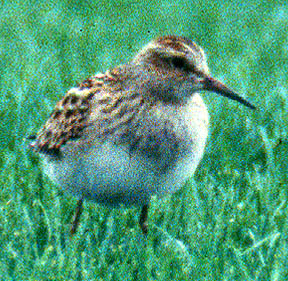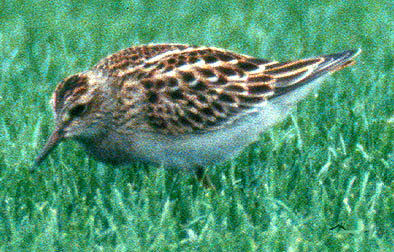November 2000 Mystery Bird
To view public comments or join the fray by adding your opinion, click here. Have
fun!
 |

Photos © Ian A. McLaren
All rights reserved. |
This controversial sandpiper was photographed at a sod farm in Delta, British Columbia on a dull rainy 28 August
1998. However, the dingy coloration of the breast was real, not a photographic artifact but the upperparts were
very bright. The bird stood out from the flock of Pectoral Sandpipers raising the possibility of Sharp-tailed
Sandpiper. The upperpart pattern is a good match for a juvenile with fresh feathers all neatly edged in white
or rust; but the underpart pattern is not unlike that of adult nonbreeding Sharp-tailed Sandpiper as illustrated
in The Sibley Guide to Birds. An Australian consultant thought it was a juvenile Sharp-tailed but was a
bit uninformative on the lack of "classical" buffy breast. Can a juvenile Sharp-tailed ever show an
adult breast pattern? I have never seen or heard of such a bird.
The consensus is that this bird was a Pectoral Sandpiper and that makes the most sense to me. Notice the heavy
streaking within the supercilium and in the ear coverts. These are more contrasting white on Sharp-tailed which
also usually shows a more prominent white eyering. For these reasons I agree with the majority of commentators
that the bird is just an odd Pectoral Sandpiper, but I am left wondering what a Pectoral x Sharp-tailed hybrid
might look like. Hybrid Calidris are notoriously scarce and I don't know if this combination has ever been
recorded. But I agree that this mystery bird is close enough to typical Pectoral that there is no compelling need
to invoke a hybrid theory. Thanks to all for the great comments.
Color perception has been a chronic problem in assessing photographic images on the web. This problem
is compounded by the wide variety of hardware and software used to view these images. Please adjust your video
to the highest possible number of colors. My logs show that over 25% of visitors view these pages with only 256
colors (8 bit). Sixteen bit (high color) is minimum and 24 bit (true color) desirable. Also you may wish to calibrate
your monitor against a color
standard and ensure that brightness and contrast are set correctly.
[Home] [California Birding]
[More Mystery Birds]



